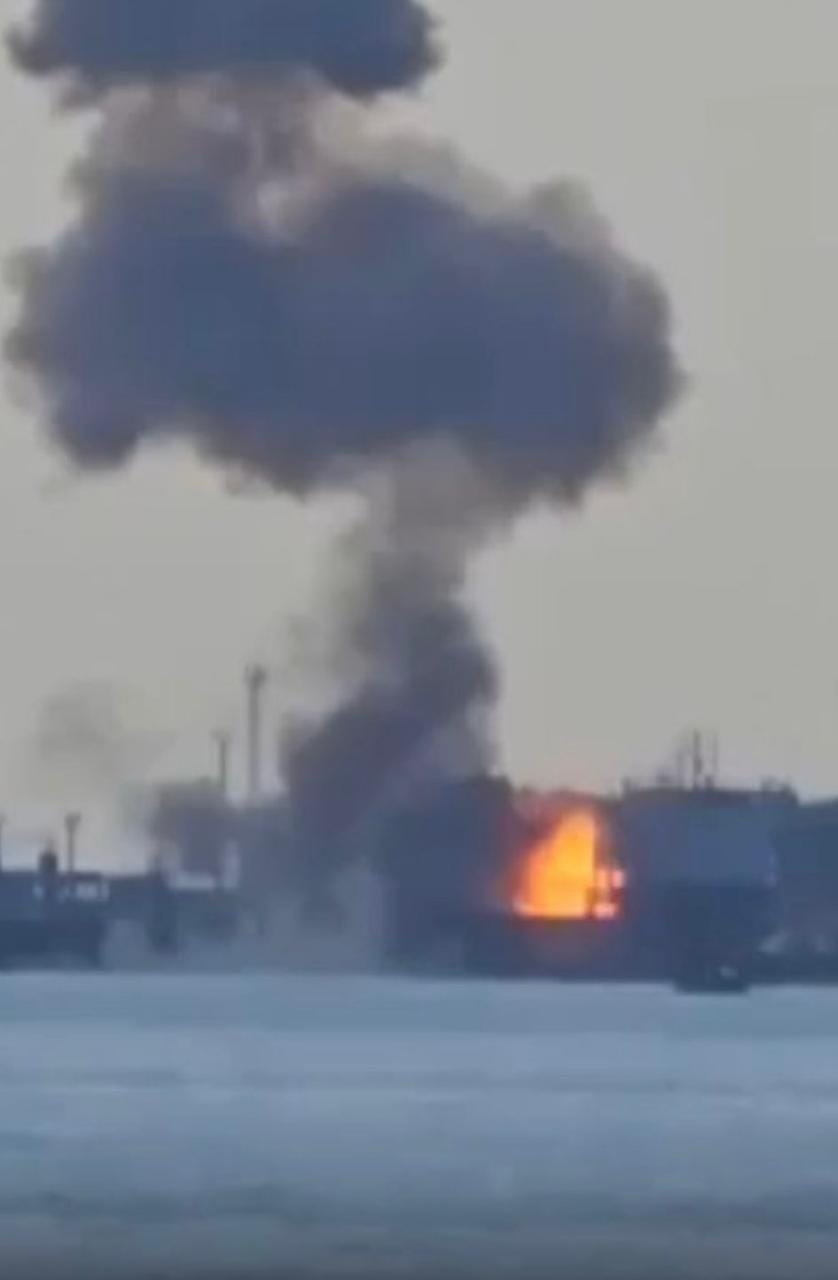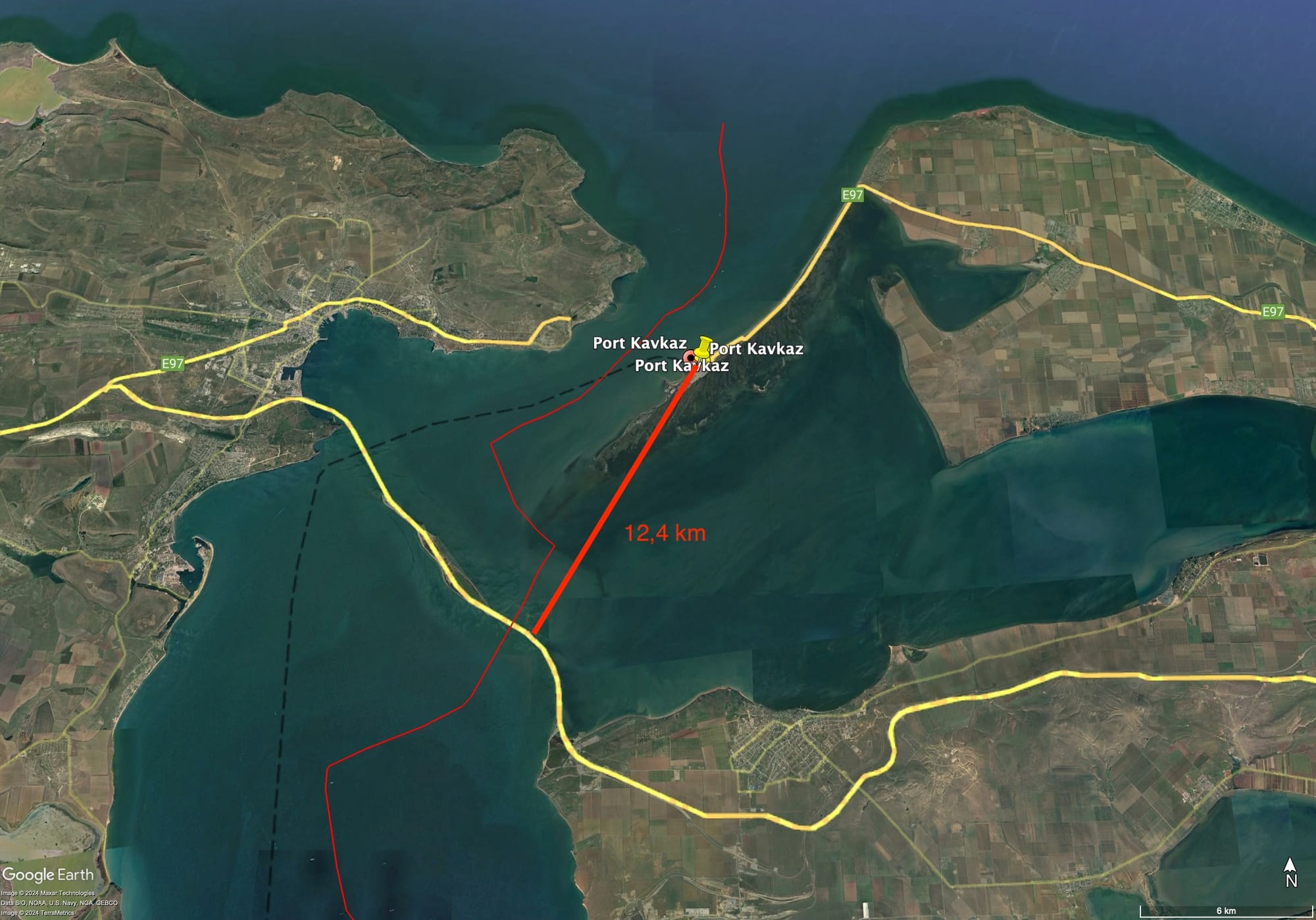Why has Ukraine not destroyed the Crimean Bridge?
Tuesday morning, Ukraine attacked the ferry Slavyanin in the Russian port of Kavkaz. Kavkaz is a harbor on the Chushka Spit about 12 kilometers northeast of the Crimean Bridge on the Russian side of the Kerch Strait. Since Ukraine bombed the bridge (twice), Russia has attempted to build alternative logistical routes, and port Kavkaz is played an important role in this. Slavyanin was Russia’s last operational rail ferry in the region because Ukraine already destroyed the other two.
Russia still has ferries that can transfer trucks, but the logistical system is very much built around railway traffic. If they have at some point to rely solely on road traffic, then that will be a significant bottleneck in their logistics. With the destruction of Slavyanin, Russia will now again have to rely on the Kerch bridge for rail traffic. They are building a new railroad line through the so-called land corridor along the northern coast of the Sea of Azov, but it is not operational yet.

This obviously creates speculation about when and if Ukraine will attack the bridge again, and in a broader perspective about what Ukraine’s strategy is for Crimea. Phillips O’Brien, who in my view is one of the best analysts of the war, explains Ukraine’s Crimea strategy as a three-step process to isolate the peninsula:
1. Cut off maritime traffic
2. Cut off air traffic
3. Cut off ground-based rail and road connections
The maritime task
The process of cutting off the maritime traffic involves targeting port facilities, shipyards, naval ships, and civilian ships that serve a purpose for military logistics. It can be hard to remember, but it has only been a year since Russia pulled out of the grain deal, and back then much of the media coverage was doom and gloom. The story was that this was going to put an end to all grain exports because Russia would enforce a blockade of the Ukrainian harbors.
I was one of the few analysts at the time who said that this was going to turn into a disaster for the Russians, because by the summer of 2023 the Ukrainians had the necessary weapons to defeat the Russian Navy. I even went so far as to suggest that maybe the Ukrainians had tricked the Russians into pulling out of the grain deal, and I still think that might have been the case.
The short version is that by the summer of 2024, the task is largely done from a maritime perspective. The Russian Black Sea fleet is hiding in the eastern end of the Black Sea to avoid being hit by Ukrainian missiles and drones. Crimea’s port infrastructure is regularly under attack, and the ferries they use for military logistics are vulnerable targets.
Defeating the air defense
The second step in the process involves the destruction of Russian air defenses and airbases. This is also right now happening at a rapid pace, and the big enabler has been the deliveries of ATACMS missiles from the United States. ATACMS are ballistic missiles, so they have a very high speed that makes them difficult to deal with for the Russian air defenses.
This means that ATACMS are superb for targeting the air defense systems themselves, and since Ukraine received these missiles in the spring, Russia has been losing a big number of high-end air defense systems. As this progresses, there will be more and more holes in the Russian air defense umbrella, and it will be easier for the Ukrainians to have success with airstrikes on other types of targets. This might be what we saw on Tuesday where seemingly the Ukrainians managed to damage a strategically important ferry with a drone strike.
Dealing with the Crimean Bridge
The last step in the process will be to cut off the roads and railroads leading into Crimea, which to a large extent means to target the bridges. This is where I begin to disagree at least partially with Phillips O’Brien. He explains the strategy as a largely chronological process, and he uses that to make an argument about why Ukraine hasn’t destroyed the Crimean Bridge yet. The argument is that it would not make sense to destroy the Crimean Bridge while Russia still has operational railroad ferries, because it would be possible to move the traffic onto a different route. But now that the last railroad ferry has been destroyed, then the destruction of the bridge will have a much bigger impact.
I think that on a conceptual level the three processes of targeting maritime, airborne, and ground traffic is a useful way to understand the tasks required for isolating Crimea and turning it into a liability for Russia. But I don’t subscribe to the idea that there are firmly defined chronological dependencies between these processes. Rather, things have been happening at the pace whereby Ukraine has been getting their hands on the required capabilities.
Even if Russia still had a functional railroad ferry, it would still have a huge impact to destroy the Crimean Bridge. Both in terms of the logistical challenges it would create for Russia and because of the political benefits. Until Tuesday, Russia had two functional railroad connections across the Kerch Strait: a bridge and a ferry. I don’t see why Ukraine would have to take out the ferry before taking out the bridge. They could just as well have done it in the opposite order.

So my reading of the incident on Tuesday is probably a bit more pessimistic. I don’t see the attack on the ferry as a necessary precursor for an attack on the Kerch Strait Bridge. Quite on the contrary, I think this attack on a harbor just 12 km from the bridge begs the question of why they haven’t then also attacked the bridge. Clearly Ukraine can conduct successful airstrikes in the area if they want to. The reason why they haven’t done it must be something else.
It’s possible Ukraine doesn’t have enough missiles to be successful. A bridge is extremely solid, and it would require a large number of missiles to take it out permanently. It’s possible that Ukraine’s Western partners haven’t provided enough missiles for the task, and that Ukraine has prioritized other targets.
But another possibility is that Ukraine isn’t allowed to hit the Crimean Bridge with Western weapons. It is fully possible that the Biden administration has delivered ATACMS missiles on the condition that they may not be used to destroy the Crimean Bridge. This would be in line with their previous policy of escalation management.
Interestingly, President Zelensky in one of his evening addresses this week teased that Ukraine is developing their own missiles to conduct long-range strikes into Russia so they won’t depend on political approval in other countries. Maybe that is their solution for the Crimean Bridge. But I think it’s difficult to see the argument for why Ukraine would have waited so long to destroy the bridge if they had to the capability to do it sooner.